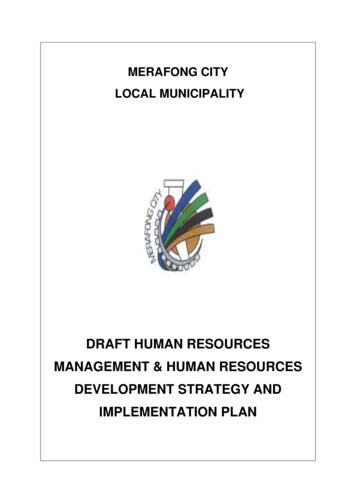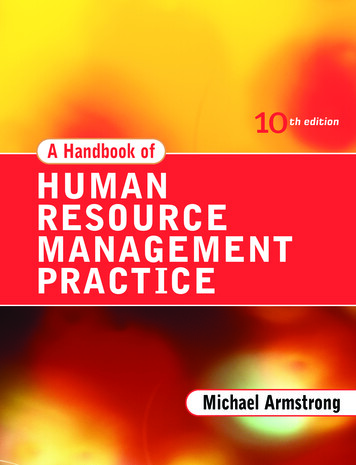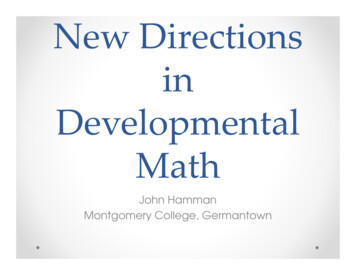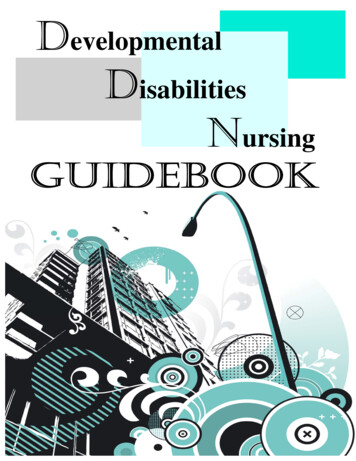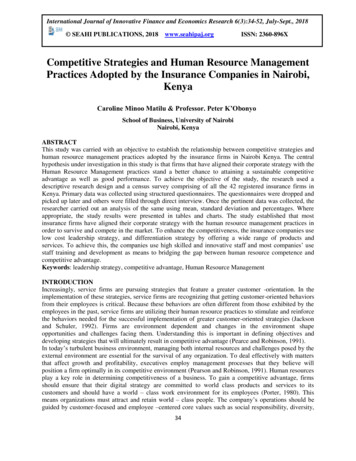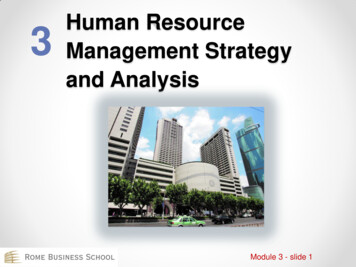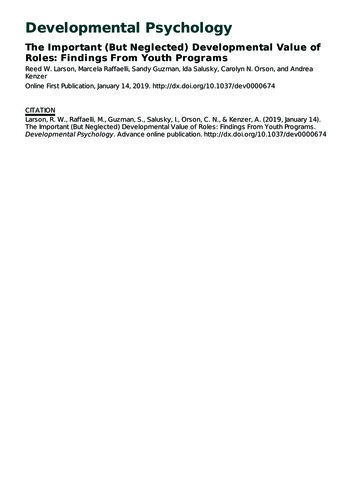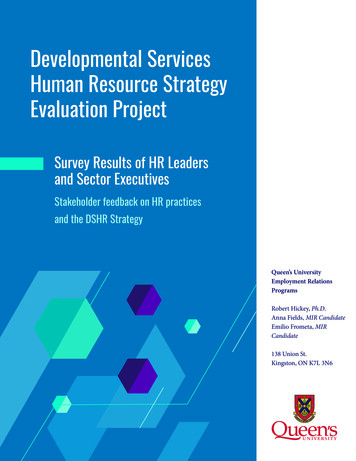
Transcription
Developmental ServicesHuman Resource StrategyEvaluation ProjectSurvey Results of HR Leadersand Sector ExecutivesStakeholder feedback on HR practicesand the DSHR StrategyQueen’s UniversityEmployment RelationsProgramsRobert Hickey, Ph.D.Anna Fields, MIR CandidateEmilio Frometa, MIRCandidate138 Union St.Kingston, ON K7L 3N6
Robert Hickey, Ph.D. Associate Professor, Employment Relations Programs,Faculty of Arts and Science, Queen’s University.Anna Fields, Master of Industrial Relations Candidate, Research Assistant,Employment Relations Programs, Queen’s University.Emilio Frometa, Master of Industrial Relations Candidate, Research Assistant,Employment Relations Programs, Queen’s University.This report is part of the Queen’s University DSHR Strategy EvaluationProject, funded by the Ontario Ministry of Community and Social Services.The findings and conclusions in this report are solely the responsibility of theauthors, and do not necessarily reflect the view of the Ontario Ministry ofCommunity and Social Services or the Government of Ontario.Ministry of Children, Community and Social ServicesIn June 2018, the Ministry of Community and Social Services merged withother areas of the provincial government to form the Ministry of Children,Community and Social Services. The DSHR Strategy Evaluation Project reportsreference to the Ministry of Community and Social Services (MCSS) to reflectthe ministerial structure involved in the DSHR Strategy during the periodunder evaluation. Throughout the entire period of the DSHR Strategy underconsideration, MCSS was the provincial partner and the ministry responsiblefor developmental services in Ontario. Developmental services, and theinitiatives associated with continuing workforce develop strategies, are nowmanaged under the Ministry of Children, Community and Social Services.Human resource practices in the developmental services sector
Table of Contents Introduction. 1 Methods . 9 Organizational Profiles. 12 Recruitment. 19 Retention. 24 Turnover. 28 Participation in the DSHR Strategy. 29 Impacts on the Agency-based Workforce. 37 Impact on Services and Supports. 39 Critical Human Resource Challenges. 40 Sustaining Workforce Development Efforts. 41 Continuing to Enhance HR Practices.44 Conclusions. 47Table of FiguresFIGURE 1: Structure of the DSHR Strategy. 3FIGURE 2: Behavioural versus technical competencies. 4FIGURE 3: Core competencies model. 5FIGURE 4: 2010 marketing brand. 7FIGURE 5: 2018 marketing brand. 7FIGURE 6: HR best practices checklist - recruitment. 8FIGURE 7: Employment status of agency-based workforce. 13FIGURE 8: Proportion of annual revenue by funding source. 14FIGURE 9: Hierarchy of human resource functions. 16Human resource practices in the developmental services sector
FIGURE 10: Scope of HR responsibilities. 17FIGURE 11: Organizational human resource capacity. 18FIGURE 12: Agency investment in the HR function. 18FIGURE 13: Improvement in HR practices. 19FIGURE 14: Major and critical barriers to recruitment. 20FIGURE 15: Minor and non-barriers to recruitment. 21FIGURE 16: Frequency of selected recruitment practices. 22FIGURE 17: Key factors in successful recruitment. 23FIGURE 18: Minor and non-barriers to retention. 24FIGURE 19: Key factors in successful retention. 25FIGURE 20: Major and critical barriers to retention. 26FIGURE 21: Job quality factors and retention failures. 27FIGURE 22: Average turnover rates by job classification. 28FIGURE 23: Trends in turnover rates for past three years. 29FIGURE 24: Overall participation in DSHR Strategy. 30FIGURE 25: Participation in the core competencies initiative. 31FIGURE 26: Participation in the Workplace Learning Project. 32FIGURE 27: Participation in the HR best practices initiative. 33FIGURE 28: Positive impacts on organizational practices. 35FIGURE 29: Agency practices least or negatively impacted. 36FIGURE 30: Positive impacts on employees. 37FIGURE 31: Least effective impacts on employees. 38FIGURE 32: Critical challenges identified by HR leaders. 40FIGURE 33: Official unemployment rate, 2002–2018. 41FIGURE 34: Importance of the DSHR Strategy. 42FIGURE 35: Factors to sustain workforce development. 42FIGURE 36: Factors to sustain efforts to improve HR practices.44Human resource practices in the developmental services sector
IntroductionThis study is part of a broader research project to evaluate the dynamics andimpacts of the Developmental Services Human Resources (DSHR) Strategy. Thegoals of the evaluation research project are to:1.Understand the DSHR Strategy’s impacts and outcomes.2. Identify the achievements and determine the effectiveness of theStrategy.3. Identify shortcomings, gaps, and emerging challenges.4. Understand the factors that enabled the outcomes.5. Inform the development of a framework for the developmental servicessector to continue advancing as a professionalized workforce in atransformed sector.This report examines the initial findings from surveys, interviews, and focusgroup meetings of human resource leaders and sector executives.BACKGROUND OF THE DSHR STRATEGYOn September 9, 2004, the Ministry of Community and Social Services(MCSS) announced a plan to transform services for people with developmentaldisabilities. The long-term goal of the transformation of developmental servicesin Ontario has been to create an accessible, fair, and sustainable system ofcommunity-based supports. In 2007, MCSS recognized the need to bringthe developmental services sector together to develop a coordinated strategyto address human resource issues and other labour market challenges in atransformed sector.In 2008, based on the recommendations of an Expert Panel on Training andthe results of a research study conducted on the developmental services sectorby Deloitte, the Provincial Network on Developmental Services (comprisingexecutives from transfer payment agencies in the developmental services sector),in collaboration with the Ministry, developed a Human Resource Strategy.The DSHR Strategy was launched with a vision and ten-year mandate toHuman resource practices in the developmental services sector1
professionalize the sector and ensure the best quality of supports for people withdevelopmental disabilities in Ontario.OBJECTIVES OF THE DSHR STRATEGYThe DSHR Strategy targeted four key objectives:1.Increased pool of qualified and engaged professionals with necessarycompetencies supporting people with developmental disabilities.2. Consistency and congruency in education, workplace learning, andprofessional development programs across Ontario’s developmentalservices sector.3. Opportunity and clarity for progression through a variety of career pathsfor all employees in the DS sector.4. Competency-based management and leadership.The evaluation project is assessing the Strategy based on these originalobjectives as well as a broader set of criteria for understanding the impact of theStrategy on work and careers in the sector.STRUCTURE OF THE DSHR STRATEGYAs shown in Figure 1, the structure of the Strategy initially included sixcommittees, each with a distinct area of focus to contribute to the overallobjectives. The committees were comprised of sector leaders from a variety oforganizations across the province. Each committee developed a work plan andset of deliverables designed to help the Strategy achieve its objectives. The chairof each committee served on the Steering Committee for the Strategy. A pair ofco-chairs, one from the sector and one from MCSS, led the Steering Committee.MCSS provided base funding for the Strategy to support a project coordinatorand key initiatives, such as the development of core competencies. Sectorexecutives and managers active on the sub-committees provided thousandsof hours of in-kind support for the Strategy. While the committee structureschanged and evolved over the ten–year period, the financial support by MCSSand the in-kind support of sector stakeholders created a stable platform for theDSHR Strategy.Human resource practices in the developmental services sector2
FIGURE 1: Structure of the DSHR StrategyHuman Resource Strategy for Developmental Services Plan: 2008–2018Increased pool of qualified developmental service professionalsConsistency in education, training, and professional development in Ontario’s DS sectorOpportunity for movement through a variety of career paths for DS professionalsExpert managementCommon understanding of the useand value of thecore competenciesfor DS staffUse of best HRpractices inrecruitment, staffrecognition,training, andretentionCore CompetenciesCommitteeBest HR PracticesCommitteeConsistent DS education program,including agency-based trainingprogramsAgency-based training is recognizedand credited in college programsAgency-basedTrainingCommitteeProgram StandardsCommitteeIncreased awareness of DS sectorand DS careeropportunitiesStrong collaborativestakeholderrelations committed to the success ofthe DSHR StrategyMarketingCommitteeShared InterestCommitteeThe Core Competencies and the Marketing and Communication subcommittees remained active during the entire strategy. However, there werechanges in the composition of the other sub-committees during the ten-yearstrategy. Three committees—the HR Best Practices, the Agency-based Trainingand the Program Standards committees—merged into the Workplace LearningCommittee. In 2015, the DSHR Strategy formed a new sub-committee focusedon succession planning and talent management. In 2017, the work of the MiddleManagement Task Group was integrated into the strategy as a new committee.CORE COMPETENCIESThe development and implementation of a model of behavioural corecompetencies for seven key positions in the sector served as a unifying themefor the overall strategy. The Core Competencies committee was responsible forthe development and implementation of the core competencies model.Identifying and developing a standard set of professional competencies in thesector was one of the primary recommendations made by the Deloitte Studyand the Expert Panel on Training. The recommendations were focused onbehavioural competencies, as distinct from technical skills and other knowledgeand abilities as shown in Figure 2. Behavioural competencies were definedand identified as the habits of mind and motivations that differentiated topHuman resource practices in the developmental services sector3
performing employees and managers.The DSHR Strategy contracted with the Hay Groupto develop the core competency models (see Figure3), including a competency dictionary, trainingprogram, and developmental resource guide. Thedevelopment of the competency model involvedextensive interviews and focus group meetings withDirect Support Professionals (DSPs), HR managers,and executive directors to identify the set of corecompetencies common and essential to DSPs andother key job classifications in the sector.The model focused on the core competencies thatdistinguished top performers, not all competenciesrequired to succeed in each role. The model wasalso designed to clarify the skills and competenciesneeded for career pathways in organizations. Forexample, some competencies, such as creativeproblem solving and decision making, required acompetency level of 3 in the DSP role and level 4 atthe front-line supervisor role.A set of threshold competencies were also includedin the model. These competencies, such as flexibility,self-control, and values and ethics, were identified asnecessary preconditions for working in the sector.FIGURE 2: Behavioural versus technical competenciesNecessary for top performance but notsufficient: central to development butleast differentiatingSkillsKnowledgeSocial ferentiating behaviours stem fromfactors below the water line: tend todrive people’s long-term behaviour andlead to longer term successThe implementation of the core competency model began with a pilot of16 organizations selected as representative agencies in the sector. The pilotimplementation provided the Strategy with feedback on potential barriersand effective strategies for training staff and promoting the core competencyframework.One important lesson from the pilot phase among DSPs was the role of unionsupport and efforts to generate a collaborative approach to the implementationof core competencies. The Shared Interest Committee facilitated discussion andcollaboration between DSPs and executives in the sector.Human resource practices in the developmental services sector4
FIGURE 3: Core competencies modelSHARED INTEREST COMMITTEEThe Shared Interest Committee facilitated dialogue among key stakeholders inthe agency-based workforce, including sector executives, non-union and unionrepresentatives. The unions included the Ontario Public Service EmployeesUnion (OPSEU), the Canadian Union of Public Employees (CUPE), and theService Employees International Union (SEIU).One of the key roles of the Shared Interest Committee was to facilitatethe implementation of core competencies among DSPs throughout thesector. The stakeholders extensively discussed the purpose and objectivesof core competencies. These discussions fed back into the work of the CoreCompetencies Committee and the DSHR Strategy Steering Committee.One of the important outputs from the Shared Interests Committee discussionswas a document titled the “Intent of core competencies.” This document wascirculated as part of the implementation strategy and facilitated the promotionof core competencies at both unionized and non-union organizations.Another contribution that the Shared Interest Committee made to theimplementation of core competencies was providing input into theimplementation guide. Specifically, the DSHR Strategy adopted and promotedHuman resource practices in the developmental services sector5
a co-facilitated model for implementing core competencies and conductingtrainings with organizations. For example, agencies were asked to send boththe training manager and a direct support professional to attend the train-thetrainer workshop on implementing core competencies. Sector executives andrepresentatives at the Shared Interest committee described this co-facilitatedmodel of training and implementing core competencies as an important featureof the implementation strategy.AGENCY-BASED TRAINING COMMITTEEThe DSHR Strategy formed the Agency-Based Training Committee to work ona number of the key recommendations from the Expert Panel on Training. Inparticular, those recommendations included developing a sector–wide trainingand development strategy that supported core competencies, recruitment andretention, career progression, and professional recognition. The committeeworked to explore potential linkages between agency-based professionaldevelopment programs and college diploma programs. The Agency-basedTraining Committee also examined leadership development programs andoptions for supporting future talent requirements and succession planning.The Agency-based Training Committee conducted an extensive survey to assessthe current landscape of training and development activities at organizations.The committee also examined the relationship between the DSW collegeprogram and agency-based training practices. The committee identified 31core topic areas but found that the sector in Ontario lacked consistency. Thecommittee generated a final report, which subsequently became the foundationfor the Workplace Learning Project.PROGRAM STANDARDS COMMITTEEThe Program Standards Committee was established to “make recommendationsto the Ministry of Training Colleges and Universities (MTCU) regarding DSprogram standards and to strategize on how to influence college curriculumto be reflective of the evolving sector.” The work of the Program StandardsCommittee focused on efforts to better align the curriculum in DSW collegediploma programs with the needs of the sector. Much of the work of theProgram Standards committee built on the model of core competencies thatwere developed and implemented for the sector. In particular, the programstandards committee discussed ways to integrate core competencies into theHuman resource practices in the developmental services sector6
developmental service worker diploma and the DSW apprenticeship program.In addition to the curricular elements of the Program Standards committeework, substantial efforts were required to develop working relationshipswith DSW college programs at the provincial level. An additional significantoutput of the Program Standards Committee was recommendations onhow local developmental service organizations could create opportunitiesto build relationships between colleges and agencies. This included bothpractical elements around best practices for college placements, but broaderstrategic aspects of enhancing the relationship between the college sector andorganizations that hire DSW graduates.MARKETING AND COMMUNICATIONS COMMITTEEThe Marketing and CommunicationsCommittee focused on the objectives associatedwith promoting the employment brandof working in developmental services andenhancing the profile of professional careersin the sector. One of the major deliverables ofthe subcommittee’s work to the DSHR Strategywas the development of marketing templatesthat organizations could adapt for their ownpromotion and recruitment campaigns.FIGURE 4: 2010 marketing brandFIGURE 5: 2018 marketing brandThe Marketing and CommunicationsCommittee also worked to promote internalcommunications of the DSHR Strategy to thesector. The committee reviewed and brandedreports, newsletters, and the DSHR websiteto promote the DSHR strategy throughoutdevelopmental service organizations in theprovince.HR BEST PRACTICES COMMITTEEThe HR Best Practices Committee was one of the original components of theDSHR strategy. The committee reviewed the recommendations of the Deloittereport and the Expert Panel on Training to identify key areas of HR practice.Human resource practices in the developmental services sector7
The committee undertook a series of regionalfocus group meetings and interviews with HRprofessionals to discuss best practices in these keyareas.FIGURE 6: HR best practices checklist - recruitmentThe work of the committee generated ready-touse checklists on what they had identified as bestpractices in the areas of recruitment, retentionand recognition, and training and professionaldevelopment. The committee also generatedsupportive materials to promote behaviour-basedinterview practices.The final report provided a detailed assessmentof the rationale, current situation, and strategiesfor improving HR practices across a range of strategic areas. For example, inthe area of recruitment, the HR Best Practices’ final report recommended thatagencies “use behavioural-based interview methods to test for core competencieswhen hiring; ensured supervisors have a role in assessing candidates to ensurecultural fit.” The rationale for this recommendation noted that the ExpertPanel on Training specifically referenced the need to use leading practices inthe selection of future workers. In the committee’s assessment of the currentsituation, they found “very few agencies in the developmental services sector areusing behavioural-based interviews as part of the selection process.” The reportwent on to identify specific actions and practices that HR managers could adoptto improve selection practices.TALENT MANAGEMENT AND SUCCESSION PLANNINGThe Succession Planning and Talent Management Committee formed to addressthe lack of formal succession plans in the sector. In 2013, the DSHR StrategySteering Committee conducted a survey of agencies regarding successionplanning and talent management practices. While most agencies had consideredissues related to succession planning, only 29 percent of survey respondentsindicated that the agency had a formal, documented succession plan for keypositions in the organization.The demographic profile of many executive directors at developmental services(DS) agencies suggested a high number of executive transitions over thesubsequent five years. The committee worked to develop manuals and otherHuman resource practices in the developmental services sector8
resources to support agencies at both the level of the Board of Directors andthe executive management team. The manuals drew upon existing effectivepractices in the not-for-profit sector and provided basic, step-by-step guidesfor developing and implementing succession planning and talent managementprograms.The committee sponsored a special one-day seminar and workshops at theannual HR forum to promote the guides. The communication strategy tothe Board of Directors also included the development of a short video aboutsuccession planning and the resources available in the manual that could beshown at local agency board meetings.MIDDLE MANAGEMENT TASK GROUPThe Middle Management (M&M) Task Group was incorporated into the DSHRStrategy in 2017. The work of the M&M task group started with initiativessupported by MCSS to explore leadership development opportunities andchallenges facing middle managers at transfer payment agencies. The 2007Deloitte study identified leadership development as a large gap that most DSagencies encountered. In addition, the initial work of the M&M Task Groupidentified unique pressures on middle managers, such as a growing scope ofresponsibilities and direct reports. The M&M Task Group has a broad mandateand multifaceted work plan to consider strategies to enhance training anddevelopment and improve supports for middle managers.CONTEXT FOR EVALUATIONResearchers at Queen’s University studied job satisfaction and work experiencesat the launch of DSHR Strategy’s core competency initiative. It is timely, nowthat the DSHR Strategy has reached the end of its ten–year mandate, that theresearch team now evaluates the impact of the Strategy on organizations, theworkforce, and services. MethodsThe research design for evaluating the role and impact of the DSHR StrategyHuman resource practices in the developmental services sector9
on the developmental services sector was primarily based on survey data,supplemented with qualitative interviews. The research team at Queen’sUniversity designed the survey for agency-based HR managers based on severalconsiderations and objectives.SURVEY DESIGNFirst, the current survey builds on the 2007 Deloitte study. For example, thecurrent survey uses the same questions for measuring barriers to recruitmentand retention. This allows for comparisons of data from the pre-Strategy timeperiod to results from the end of the DSHR Strategy’s ten–year mandate.Second, the survey measured participation in the specific aspects of theDSHR Strategy to gain a better understanding of the breadth and depth ofparticipation by DS agencies. Third, the survey asked HR leaders to assess theimpact of the DSHR Strategy on the organization, the agency-based workforce,and on services and supports. The survey included a number of qualitative,open-ended questions regarding recruitment, retention, critical HR challengesfacing the organization and ideas about ways to sustain workforce development,and strategies to enhance HR practices. Finally, the survey solicited open-endedresponses to three critical questions:1.Please identify the most critical human resource challenge currentlyfacing your organization.2. What is the most important factor that will help the DS sector tocontinue developing a professional and qualified workforce to meetevolving expectations and needs in the sector?3. Please describe one way that stakeholders can sustain a coordinatedstrategy to improve HR practices in the sector.SURVEY DISTRIBUTION AND DATA COLLECTIONThe survey was distributed in both electronic and paper format. An invitationto participate was distributed through a variety of email networks including theOntario Agencies Supporting Individuals with Special Needs (OASIS) ExecutiveDirector list-serve, the OASIS HR list, the Community Living Ontario ExecutiveDirectors’ list, and regional HR networks.Human resource practices in the developmental services sector10
While MCSS funds 380 distinct entities in Ontario, this study invited the 200organizations with operations focused on developmental services to participatein the study. The total survey population included HR leaders from 200organizations. A total of 84 surveys were submitted for a response rate of 42percent.Survey data were imported into a statistical software package, SPSS 24. Theanalytical strategy began with a review and structuring of the data. Electronicsurveys that had no completed fields were discarded. Partially completedsurveys were retained and the incomplete sections were treated as missing data.This report focuses on the findings in the descriptive statistics of the data.EVALUATION PROJECT ADVISORY COMMITTEEThe researcher team at Queen’s University has worked with and received inputfrom an advisory committee of executives, college faculty, MCSS officials, andan independent HR professional. The advisory committee members included:Ann-Marie BinettiDSHR Strategy Project CoordinatorAnn BilodeauKW Habilitation ServicesLuciano Contini HR Capacity Management ConsultingAisha Dag-EllamsMCSSHolly DuffFanshawe CollegeKrista LordMCSSJoe PersaudCommunity Living TorontoNancy Wallace-GeroCommunity Living Essex CountyThe Queen’s University’s General Research Ethics Board reviewed and approvedthe project’s ethical protocols and data collection instruments. These ethicalprotocols included the protection of confidentiality of individual participantsand their organizational affiliations.Human resource practices in the developmental services sector11
Organizational ProfilesHUMAN RESOURCE CAPACITY AND STAFFPrevious studies have explored the size of HR staff and capacity of the HRfunction in organizations. For example, a 2017 survey of HR capacity found thatDS organizations had 2.7 full-time equivalent (FTE) staff in the HR function onaverage.However, there was significant variation in which most of the smallerorganizations do not have a separate, dedicated staff member to lead the HRfunction. Instead, many organizations rely on multi-functional executiveswith a broad portfolio of responsibilities. In the current survey, 11 percent ofrespondents indicated that the human resource function was not their primaryarea of responsibility.11%of respondentsexperienced roleconflict. Therespondent wasresponsible forthe HR function,but HR was nottheir primaryresponsibility.AGENCY-BASED WORKFORCE COMPLEMENTOrganizations ranged in size from 24 employees to over 3,700 employees. Asshown in the table below, the average number of full-time employees was 136,with a range from 0 to 1,429. The average number of part-time and casualemployees was 105 and 49, respectively.TABLE 1: Workforce characteristics of r
group meetings of human resource leaders and sector executives. BACKGROUND OF THE DSHR STRATEGY On September 9, 2004, the Ministry of Community and Social Services (MCSS) announced a plan to transform services for people with developmental disabilities. The long-term goal of the transformation of developmental services

